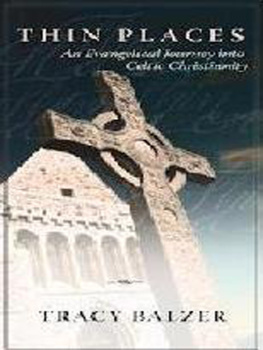
Praise for A Journey of Sea and Stone
Which books keep you sane when the world locks you down? For me its those with marrow-deep ties to the geography they describeWendell Berrys Port William stories, Timothy Egans pilgrimage to Rome, Henry Bestons year on the beach at Cape Cod. New to this heartening shelf is Tracy Balzers A Journey of Sea and Stone, the tale of her longstanding love for the cloistered island of Iona, off the Scottish coast. We all have places we seem to have known forever. In lucid, rhythmic prose, Balzer develops a spiritual travelogue of solace and gratitude, of openness to wonder and reason, and of a longing for what Beston called the dear earth itself underfoot. This is a welcome book.
Leif Enger, author of Peace Like a River
A visionary, Tracy Balzer draws us in to a vivid sense of what holiness looks like, feels like. She demonstrates how anyone who experiences this transformative power can never again be the sameit is that radical.
Luci Shaw, Writer in Residence, Regent College, and author of The Generosity and Eye of the Beholder
This book is about listening and looking and learning; it is about being deeply there to hear the heartbeat of a place, and the teaching that comes from all these things is gracious and generous. This work is like a polished serpentine stone from St. Columbas Bay on Iona: hold it to the light and you find more every time you look.
Kenneth Steven, author and poet
The ancient tradition of spiritual pilgrimage reminds us that ordinary places can be holy places. Tracy Balzer takes us to the holy Isle of Iona to find fresh inspiration and meaning in our daily lives. If you want a spiritual pilgrimage that will renew your faith, you dont have to travel far. All you have to do is read this book!
Dr. Winfield Bevins, director of church planting at Asbury Seminary and author of Ever Ancient, Ever New
Tracy Balzer has given us all a wonderful gift. She invites us into sacred spaces and reminds us that we, on our own soulful journeys, are on holy ground.
Brent Bill, author of Holy Silence: The Gift of Quaker Spirituality
The real gift of Balzers book is learning that our ordinary lives and receptive hearts can become sacred islands in their own right as we create sanctuaries for ourselves and one another.
Lisa Deam, author of 3000 Miles to Jesus: Pilgrimage as a Way of Life for Spiritual Seekers
A Journey of Sea and Stone
A Journey of Sea and Stone
How Holy Places Guide and Renew Us
Tracy Balzer
Broadleaf Books
Minneapolis
A JOURNEY OF SEA AND STONE
How Holy Places Guide and Renew Us
Copyright 2021 Tracy Balzer. Printed by Broadleaf Books, an imprint of 1517 Media. All rights reserved. Except for brief quotations in critical articles or reviews, no part of this book may be reproduced in any manner without prior written permission from the publisher. Email or write to Permissions, Broadleaf Books, PO Box 1209, Minneapolis, MN 55440-1209.
All Scripture quotations, unless otherwise indicated, are taken from the Holy Bible, New International Version, NIV. Copyright 1973, 1978, 1984, 2011 by Biblica, Inc. Used by permission of Zondervan. All rights reserved worldwide. www.zondervan.com The NIV and New International Version are trademarks registered in the United States Patent and Trademark Office by Biblica, Inc.
Scripture quotations marked MSG are taken from THE MESSAGE, copyright 1993, 2002, 2018 by Eugene H. Peterson. Used by permission of NavPress. All rights reserved. Represented by Tyndale House Publishers, a Division of Tyndale House Ministries.
Cover image: Shutterstock
Cover design: Gearbox
Interior artwork: Paul Soupiset | Soupiset Design
Print ISBN: 978-1-5064-6459-6
eBook ISBN: 978-1-5064-6460-2
While the author and 1517 Media have confirmed that all references to website addresses (URLs) were accurate at the time of writing, URLs may have expired or changed since the manuscript was prepared.
For my granddaughter,
Lizzy Iona
Contents
The last time I moved across the country I had to start building a relationship with the trees.
I grew up in a little town called Mukilteo, about thirty miles north of Seattle in the Pacific Northwest of the United States, which means I grew up with large trees. Sure, pine and fir trees were around, but what is embedded in my very being are the cedar trees. Tall and looming, reaching up to the heavens, the Empire State Buildings of the forest foliage. They have a distinct reddish interior underneath their flaky bark, which juxtaposes pleasingly against the forever green landscape.
Cedar trees arent great climbing trees. Their limbs begin too high off the ground. But that doesnt mean they remain strangers to the local inhabitants. They provide shelter from the never-ending rain. They provide a buffer from the battering wind storms that rip through the neighborhoods every now and then. Although some, if its their time, fall to the earth from which they grew, and we all pray that their descent isnt stopped prematurely by a parked car or a family house.
To live in the Pacific Northwest is to dwell with the trees. Weve built society around them. Weve built society from them. They are the source material in which we build our homes. We sleep in the trees just like the squirrels and ravens do. They are the source material for our furniture. They hold us just like the slugs and the mountain lion. They give us warmth in our hearth. They provide a way to tell our story, best exampled by the indigenous communities who erected totem poles throughout the area, carved from the bodies of red cedars. They, in a way, remind you of who you are.
Ive lived most of my life in the Northwest, but just recently my family moved to Austin, Texas. We moved right at the beginning of the coronavirus pandemic, meaning we moved to a new community when that community had become unavailable. Distanced. Sheltered in place. Closed and unavailable. Its weird to move to a bustling city where the bustle has been put on hold for the foreseeable future. All of our normal ways of connection had gone away. Restaurants, parks, churches, schools, festivals... all on hold for the good of all. Even our friends here had some complications, so our first month was just us holed up in a rental house with not much to do except to go on neighborhood walks.
It was on these walks that I began my relationship with the central Texas oak tree.
If a cedars ambition is to reach the heavens, the oak trees ambition is to open its arms as wide as possible. Its a loving gesture, actually, because to survive a central Texas summer is to find where the shade is. Oak trees are masters of shade. Their limbs grow unbelievably long. They splinter out like the spiderweb crack in your windshield, sometimes even touching the ground and raising up again for another go at winning the long-distance medal. They are amazing climbing trees, as my kids have discovered. They are also an amazing place to talk with a friend, or have a meal, or take a much-needed nap.
I didnt know this at first. The oak tree was a stranger to me, and I to it. To begin a homestead in a new place is to start a conversation with the landscape. I felt like a stranger for a long time because I didnt know what the oak trees had to say about me. Who I was and where I was connected to the universe. And frankly, I didnt know what I could share about them. We had only had quick pleasantries in times past when I had visited Austin as a tourist. Now we were neighbors. And weve had so much to talk about since I moved into the neighborhood.
Next page










